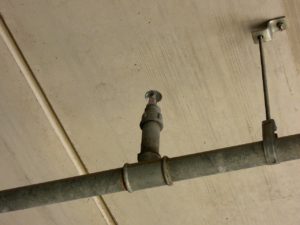Inevitably we all design a project where the pressures from the flow test are less then desirable. We layout our fire sprinkler heads and pipe to do a preliminary calculation and input our flow test into the calc program. It’s then we realize, we can’t get a safety factor on the system…our calc fails. So we do our normal routine of increasing pipe sizes, changing k-factor of heads, and changing the pipe schedule of pipe to be used but nothing seems to work. After every trick in our bag is exhausted, nervousness sets in…..thoughts of fire pumps and an uncomfortable meeting with the general contractor cross our mind.

Before we give up all hope, here is a trick I learned that has bailed me out more then a couple of times. Try lowering the sprinkler head spacing to achieve a 7 psi end head pressure. This is a high efficient sprinkler head spacing to reduce the amount of pressure the fire sprinkler system starts with and then hopefully reduce the amount of pressure required at the city water supply. For an example, lets say we have a warehouse that requires a 0.20 gpm/sq.ft. density and 5.6 K-Factor heads are to be used in the system. Assuming the system has already been designed as a grid, larger pipes sizes have been accounted for, and the pipe types have been all changed to schedule 10, we determine that the sprinkler head spacing needs to be reduced to maximize pressure efficiency. How do we do this? We know our K-Factor, 5.6. We know our desired pressure, 7 psi. So if we use the formula Q=K√(P), we can determine the gallons per minute (GPM) our sprinkler head will discharge at 7 psi. Once we have the GPM for the sprinkler head, we will need to take the GPM and divide it by the density that the sprinkler head is required to discharge. The result gives us the maximum square foot per sprinkler head needed to achieve 7 psi. So in our example, we use the Q=K√(P) formula where K=5.6 and P=7, or Q=5.6√(7). This results in Q = 14.82 GPM (rounded up). Our next step is to take the GPM of 14.82 and divide it by the desired sprinkler head density of 0.20 gpm/sq.ft. which results in 74.08 sq.ft.. So to achieve a 7 psi end head pressure, we need to space our fire sprinkler heads at a maximum of 74 square feet per head (rounded down). Pretty neat huh! If you want, you can calculate the numbers again but change the K-Factor to 8.0 to see the difference the K-Factor of your sprinkler head makes.
The largest draw back to this approach is that more sprinkler heads and probably more sprinkler branch lines will be required for the project over what was initially bid. However, it would still be much cheaper then buying a fire pump.
Do you have a favorite tip or trick on how to get sprinkler systems to calc properly when dealing with low available water pressures? Write a comment below, I would love to hear about it.
